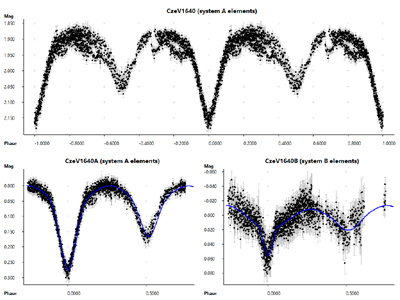|
Majority of stars in our Galaxy are not alone, possibly with a
family of planets, but they occur in pairs (binary stars) or even
higher-count systems (triple stars, quadruple stars, …).
When the orbital plane of binary star orbit is oriented (at last
approximately) in the direction towards our Sun, we can observe mutual
eclipses of both stars. In such case brightness of such star
periodically drops and the star reveals itself as an “eclipsing
binary”. (Remember, no telescope can distinguish close binary star
as two points, they always appear as single star. So, if no eclipses
occur from our point of view, chances to discover any particular star
is a binary are very low as only time consuming and expensive
acquiring of spectrum using some giant telescope can reveal it.)

There are hundreds of thousands (or maybe millions) of eclipsing
binary stars observable on our sky. But only rarely more binary stars
in multiple-star systems show eclipses. At the same time such
exceptional cases are important as they allow to us study many aspects
of stellar evolution, migration of stars or even planes in planetary
systems and other important questions of current astrophysics. The
image above shows how brightness changes of double-eclipsing quadruple
star system CzeV1640 reveal itself in light curve (top panel) and also
brightness changes of both eclipsing binaries with influence of the
complementing binary mathematically removed (bottom left and right
panels).
This particular quadruple star was discovered using G4-16000 CCD
camera on 30cm custom-built telescope. We are really happy when we see
our cameras not only providing beautiful and breathtaking images, but
also contributing to our understanding of the universe we live in.
More details about the CzeV1640 quadruple star system are available
online Res. Notes AAS 3 80.
| 